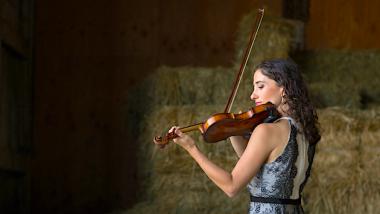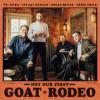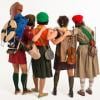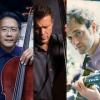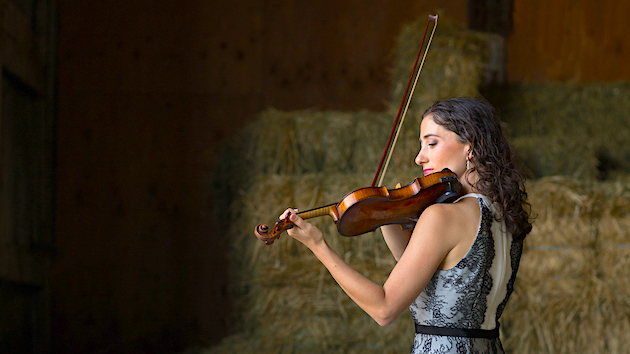
A new Scroggins & Rose CD, Curios, from the duo formed by San Francisco-based violinist Alisa Rose and Nashville-based mandolinist Tristan Scroggins, arrives as their once-rare collaborative process becomes normative. Cross-genre fever between musicians flourishes during the coronavirus lockdown and with reduced performance calendars. Projects for creating new music occur mostly from a distance, meaning working online is frequently the only ship in port these days.
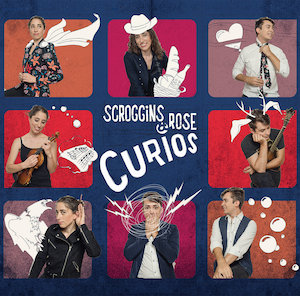 But long before the age of Zoom-is-us, the duo already blended their classical music and bluegrass backgrounds while operating from geographically separate islands. With Rose in the Bay Area and Scroggins on the eastern side of the continent, their direct interactions were anomalies: intense, week-long rehearsal sessions and special, super-small performances of new work in intimate spaces with limited audiences. That direct musician-to-musician exchange and audience feedback, Rose says in a phone interview, is connectivity that is sorely missed.
But long before the age of Zoom-is-us, the duo already blended their classical music and bluegrass backgrounds while operating from geographically separate islands. With Rose in the Bay Area and Scroggins on the eastern side of the continent, their direct interactions were anomalies: intense, week-long rehearsal sessions and special, super-small performances of new work in intimate spaces with limited audiences. That direct musician-to-musician exchange and audience feedback, Rose says in a phone interview, is connectivity that is sorely missed.
Rose earned a bachelor’s degree in violin performance and a master’s degree in chamber music from the San Francisco Conservatory of Music. She was a member of Real Vocal String Quartet (2006–2016) and credits her education as a composer to the groups’ innovative improvisational approach. As a former member of Quartet San Francisco, she and the quartet were nominated for a Grammy in 2009 for their album QSF plays Brubeck. Rose has performed at Hardly Strictly Bluegrass, on PBS’s Song of the Mountains, and in Carnegie Hall.
Growing up in Verona, Wisconsin, what were the primary family music traditions?
My mom loves folk music, so there was definitely folk music on the radio a lot, or on records, CDs, tapes. My dad loved classical music, so he would blast operas in the car. I got some of my early roots from that. My mother listened to that wonderful program from Madison, [Wisconsin] — Simply Folk. She would record it on tapes and then play it in the car. My dad liked chamber music, orchestral music. He had a whole collection of LPs I started going through in my teens. [Cellist] János Starker and classical chamber music greats. It wasn’t reverential listening. It was more like on in the background.
While studying music, what did you listen to most often? What music most influenced you as a student and during your young adult years?
I was busy listening to violin concertos and string quartets. I was in love with the whole wonderful classical repertoire. And violin sonatas, all the stuff I was working on in school. I also got intrigued with fiddle. I had done a little bit of fiddling as a kid but I really started to get into it and listen to it more in college. I got one of Darol Anger’s CD, Diary of a Fiddler, and that, I listened to over and over. I loved classical string quartets too, but in that [Anger] CD it’s the string instruments playing together. I loved the energy of it; the strong melodies. It has tremendous energy and a joyfulness to it. There’s something that’s wide when string instruments are playing well together, whether it’s fiddles or the Juilliard String Quartet. A few fiddles, a viola and a cello — or a violin, cello, and a guitar — I just love the sound.
There’s a vocal quality to the instruments perhaps?
That’s part of why I like the violin: how vocal it is. It’s super melodic, but it also has a tremendous rhythmic energy and drive. That’s what I’m drawn to.
Choosing to be a violinist, music educator, and composer: What drives that choice? Did you ever seriously consider other careers?
I did. My first year of school I actually was trying to do a double degree in biology or physics or some science-related thing and violin performance. I went to the University of Rochester and Eastman School of Music. After a year, it was just not quite the right fit. It was a culture shock but I came away with deciding maybe I just need to choose music. I took a whole year off and did classes in Madison, taught kids. Then I auditioned before coming to San Francisco.
I definitely imagine I could have gone a more academic path. I chose music because I was drawn to the expression of it and the connection I find through it. The things that drew me to it was playing string quartets with other people, playing in the youth orchestra in high school and loving it, creating music with other people and how inspiring that is. Even going to a jam and playing with other people, I find it to be personal and meaningful.
As a composer for the violin, what do you encounter when combining American folk techniques with classical concert forms? Does writing music for violin that blends these aspects introduce unique complications or opportunities?
There are a lot of challenges. Fiddle tunes tend to be short forms with two parts that are strongly anchored in one key. Classical music tends to travel through keys and have a much longer form. Combining the two, it’s hard to get a melody that has these folk influences like being anchored in one key to travel through a variety of keys. I’m meaning for a tune to tell one story, but you can fragment it in different ways, use different textures and development. The nature of it being a simpler rhythmic cell makes it difficult to morph.
Otherwise, figuring out how to keep the things that make it have the right sound for American folk music, the idiomatic details of slide, bow rhythms — are hard to translate to notation. Even the right kinds of articulation are difficult to write down. Most folk music is from oral tradition. Classical notation is written, but has limitations in that regard. I always hope people refer to recordings that are sound versions so that they get some ideas from that. I don’t think you can entirely write either form of music down with notation.
Do classical musicians often refer to recordings or video tapes of performance?
Classical musicians are less used to doing things that way. It’s a cultural difference. They’re less likely to refer to a video tape or an oral form. They’re not used to learning things by ear. Learning off the page is wonderful, but sometimes limiting.
Does the violin lend itself to diverse compositional approaches and blending with mandolin or alternative instrumental voices?
A duo with mandolin has its own difficulties. One being balance. The fiddle and violin are built to project into a large concert hall space. I use my classical violin for playing with Tristan. The mandolin is loud, but doesn’t have the same send as a violin. I have to be not busy underneath him. Figuring out how to support his sound is complicated. I’ve ended up doing a lot of pizzicato [plucking] techniques, playing quietly underneath him, and yet keep that rhythmic intensity at the same time.
In a string quartet, it’s an easier translation of folk idioms, but the notational part is difficult and sometimes, getting a great groove is harder. You can spend so much time trying to get wonderful grooves, but it’s important. Instead of a flexible timing approach, used when you’re following the melody like you would in (classical) string quartet repertoire, when you’re doing a fiddle tune or a popular arrangement, you have to create a strong groove like a band.
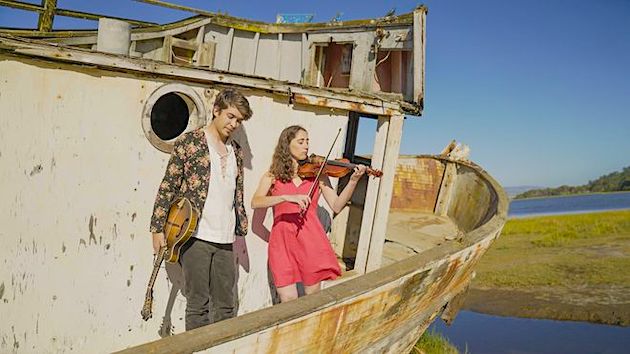
Long before COVID-19 meant partnerships had to be conducted from a distance, you and Tristan were working across vast geographical divides. Even so, the pandemic meant you couldn’t join for the intimate live performances that are the duo’s specialty. What do you miss most about that?
I miss all of it. I miss rehearsing, playing music with another person. I was drawn to playing music because it’s such a wonderful connection. It’s a nonverbal but meaningful connection. Also, with the audience, it changes entirely. Sound is physical; it’s sound waves. So experiencing sound with another person and with an audience — you can’t really replicate it online. I’m grateful we have modern technology so I’ve been able to do concerts online, but it’s really no substitute.
When I play music for an audience, it feels way more meaningful. With a piece I’ve written and haven’t played for anyone yet, once I play it in front of people, I can see what it’s about. It changes the meaning. I have something I think I’m going to do when I’m preparing for performance, but sometimes (after a performance) I discover what it’s actually about.
Please talk about the background and traditions behind “Jackalope” and “Stellar Sea,” two tracks on the new CD. They offer diversity, but collectively, what makes them recognizable as signature compositions of Scroggins & Rose?
“Jackalope” is one Tristan brought and he had the idea for it. “Jackalope” didn’t have a name when we developed it into the tune. It had two sections and then we decided it needed a bridge so we added a third section. It got its name at one of the early performances in the Sunset [District of San Francisco]. We were in the green room and noticed there was a jackalope head on the wall. We were calling the tune “C,” because it’s in the key of C, for a long time. We looked for a name that was funky with attitude.
Sometimes it’s hard to name tunes. You know what the character is from playing it, but not in a verbal way. You can change how people hear the tune depending on how you name it. It doesn’t change the sound itself but it has some importance to it. “Jackalope” got developed working with an amazing banjo player and our producer, Wes Corbett. We thinned out the first iteration of the melody and weighted the funky. We made the end of it sweeter so the whole thing has a clearer arch.
And “Stellar Sea”?
It’s another one Tristan wrote and he brought that first melody. He’d moved to Nashville and he has a great friend there, Justin Hitner, who’s a banjo player. He wrote this song while Justin was gone on tour and he was missing him. Justin is an avid bird watcher and Stellar’s sea eagle is a bird Tristan likes.
We’d been thinking about counterpoint and how we could work two melodies into our tunes. I wrote some inventions, like a fiddle invention that isn’t on the album. We played around with a concept: How do you have two melodies playing at the same time?
That [track] got shaped by where we recorded it: a beautiful church in Nashville, the Downtown Presbyterian Church. The room is a gorgeous sounding room. We were going to have the mandolin start alone, but our producer was like, “I think it should start with violin alone. Why don’t you switch it?” The violin does the melody, with all that natural reverb that gives it a softness. The room becomes like a third member in how it influences the sound.
Is there another track based in classical music that people might find interesting?
“The French Cowboy” started out trying to find a tune we could create with sound that would widen the textures. We were exploring different harmonics, playing high on the G string with a flowing bow and fingerpicking techniques [on the mandolin], trying to find different colors.
I came up with the melody and we reworked it four to six times, in completely different iterations. I had the idea of it being an Americana, folky, fiddly waltz — mixed with Debussy colors and textures. Tristan said, “You know it would actually work with this cowboy melody.” We ended up blending those two. I play impressionistically and he goes into a cowboy version. It’s a conversation going back and forth between those things. “Cowboy” is a specific sound. It’s a rhythmic sound, “de-dink, de-dink, de-dink,” that imitates banjo or guitar. It imitates music on those tv sitcoms about cowboys crossing the Western plains on their horses.
What can you tell us about the expanded group of tracks in the special “Living Room Edition” Curios release that includes commentary from you and Tristan?
The idea of that — especially in this time when you can’t go to concerts — is that a big part of our show is conversational. We like performing in concert halls too, but we do a lot of house concerts and want our music to feel friendly. No matter where we perform, we want to keep that intimate feeling. We get feedback from audiences that they like the banter. The Living Room version is like you’re listening to the concert at home. You can hear us chatter about what’s inspired each tune.
Let’s talk about improvisation from your three perspectives as a classically trained violinist, composer, and educator.
I feel lucky that I started with the Suzuki Method. It means my first way I learned music was by ear. I also studied American folk music and improvisation. There’s a lot of fear around improvisation, even beyond young classical players. I think anyone can learn it. It’s a skill you can practice and get better. My path into it came through fiddling and folk music. I remember playing with older fiddlers when I was 12 and thinking it was cool how they were playing around a melody and spiraling around it. I was fascinated.
I joined a bluegrass band while I was at the conservatory. I hadn’t played by ear with people. I jumped into it and would listen to rehearsal tapes from the previous week during my long bus ride to get there and back. It was learning by doing and it wasn’t super complex. I was able to follow my fingers around and get used to finding my way around the violin. I started saying yes to any experiences that involved improvising because I thought it was challenging and fun.
Hearing chords has taken me a long time to develop. Picking out melodies is easier, I’m a violinist so I’ve been trained to think about melodies from a young age. Hearing underlying structure has taken longer. I’m still working on developing my ears to hear more complex chords and to be more free in my improvisation. Practicing frees you up. You’re used to connecting with your own creative impulse and voice.
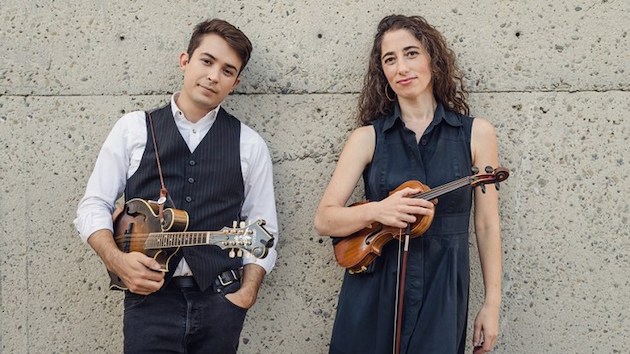
As an educator, what approach do you find most beneficial when teaching students to improvise?
Last year I taught a contemporary music improvisation ensemble course. The students are already very skilled musicians and know how to listen to each other. It’s a little bit of “just add water.” I do different exercises or games that make it not intimidating. Maybe we explore one note improvs, or only rhythm. It develops these small cells that are central to crafting music. People are freed up by having a framework that is small enough that they don’t get freaked out. Saying, “Play anything,” is scary. But an improv with one note is less intimidating. Then, you broaden the framework slowly.
Also freeing is focusing on the interactions with other musicians; because that’s a huge part of what it’s about. It keeps you from self-editing. “Flip Flop Duet” is an example: Two people come up with an idea and play their ideas at the same time, gradually switching to the other person’s idea while continuing to play.
When you are tapped out creatively, what listening practices restore your energy?
I definitely sometimes need to not listen to anything. I go to the ocean or the redwoods. If my brain is too full, I need a break from any sound. Then when I do start to want to listen to music, it varies widely. My boyfriend is not a musician and listens to different music than I do, so at home, I’m listening to Depeche Mode, hip-hop ... It’s fairly hilarious how little our musical tastes overlap. It’s refreshing to listen to something that doesn’t have a violin in it.
Do you turn to other escapes outside of music?
My main escape is exploring coastlines or hanging out with friends. During the pandemic I’ve had random escapes: water coloring, and definitely more cooking. I have a hobby instrument. I’m not very good at it, but that’s sort of the point. It’s a [five-string] clawhammer banjo I play, just for fun.
When live performances resume, what will be the first thing you hope to do?
Definitely play with other people. Some of this music from the CD with Tristan. Improvise on fiddle tunes and stuff we’ve been working on for so long. And string quartets: Schubert or Mendelssohn or Beethoven.
I recently received the San Francisco Individual Artist Commission Grant to write and premiere a concerto with the Bay Area Rainbow Symphony based on interviews with members of Bluegrass Pride. I will perform a version of this piece that will be performed with Squid Inc. string quartet. Bluegrass Pride is a wonderful organization dedicated to making the bluegrass community a welcoming place for everyone. I want to support the movement toward cultural change and inclusivity that Bluegrass Pride represents. I hope diverse audiences can connect not only with the music, but also with each other, around the shared experience of discovery through listening. As a composer, I strive to tell personal stories and give voice to those who are not always heard through music.

